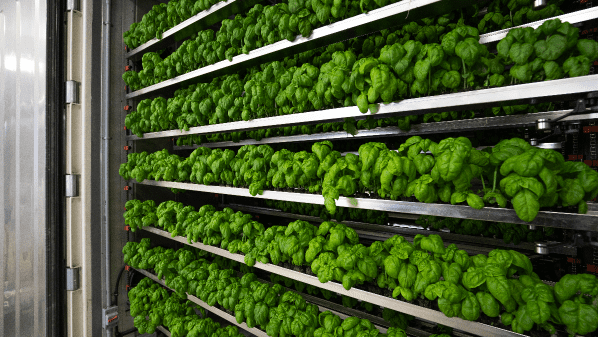Herbs grown by CubicFarm.
Focusing squarely on the technological solutions side, Canadian firm CubicFarm Systems Corporation, from Langley, BC, takes a different approach to the vertical farming concept.
Rather than stacking, CubicFarm uses a patented crop motion technology, comprising an undulating path that moves hundreds of trays of plants under a row of lights.
According to CEO Dave Dinesen, the system minimizes energy, maximizes light exposure, and reduces labor costs via a design that utilizes every foot of cubic space in a room for growing.
Founded by Dutch father and son ex-pats Jack and Leo Benne, also behind propagation greenhouse operation Bevo Farms, CubicFarm’s aim is to help domestic growers compete effectively with imported products.
Dinesen says a distinctive feature of the technology is its ability to achieve “air pruning,” a process which limits root length by bringing them into contact with the air as they grow. The advantage here, he says, is the plants can be moved easily without dragging long tangles of roots.
“We go from seed to seedling in very high densities: one of our machines will propagate 2.5 to 3 million seedlings, so it’s enormously productive,” he explains.
“Our propagation machine can be used next to a greenhouse, meaning you can save floor space and achieve 100-percent germination.”
CubicFarm offers “grow rooms” that optimize lighting, temperature, humidity, and carbon dioxide for individual crops. For this technology, the future looks bright.
CubicFarm sold a 96-machine “Fresh Hub” capable of producing 10 million heads of lettuce a year to a British Columbia company in 2021 and is expecting further growth.
“The market wants big, localized production, so companies can stop importing high-volume short shelf-life products,” emphasizes Dinesen.
“More and more of us are eating leafy greens,” he adds, but much can be lost due to high perishability and cross-country transit. “Now the technology exists to do all this locally, at a price competitive with imports. Add in the environmental benefits, and it’s a no brainer.”
This is an excerpt from the Applied Technology feature in the March/April 2022 issue of Produce Blueprints Magazine. Click here to read the whole issue.
Focusing squarely on the technological solutions side, Canadian firm CubicFarm Systems Corporation, from Langley, BC, takes a different approach to the vertical farming concept.
Rather than stacking, CubicFarm uses a patented crop motion technology, comprising an undulating path that moves hundreds of trays of plants under a row of lights.
According to CEO Dave Dinesen, the system minimizes energy, maximizes light exposure, and reduces labor costs via a design that utilizes every foot of cubic space in a room for growing.
Founded by Dutch father and son ex-pats Jack and Leo Benne, also behind propagation greenhouse operation Bevo Farms, CubicFarm’s aim is to help domestic growers compete effectively with imported products.
Dinesen says a distinctive feature of the technology is its ability to achieve “air pruning,” a process which limits root length by bringing them into contact with the air as they grow. The advantage here, he says, is the plants can be moved easily without dragging long tangles of roots.
“We go from seed to seedling in very high densities: one of our machines will propagate 2.5 to 3 million seedlings, so it’s enormously productive,” he explains.
“Our propagation machine can be used next to a greenhouse, meaning you can save floor space and achieve 100-percent germination.”
CubicFarm offers “grow rooms” that optimize lighting, temperature, humidity, and carbon dioxide for individual crops. For this technology, the future looks bright.
CubicFarm sold a 96-machine “Fresh Hub” capable of producing 10 million heads of lettuce a year to a British Columbia company in 2021 and is expecting further growth.
“The market wants big, localized production, so companies can stop importing high-volume short shelf-life products,” emphasizes Dinesen.
“More and more of us are eating leafy greens,” he adds, but much can be lost due to high perishability and cross-country transit. “Now the technology exists to do all this locally, at a price competitive with imports. Add in the environmental benefits, and it’s a no brainer.”
This is an excerpt from the Applied Technology feature in the March/April 2022 issue of Produce Blueprints Magazine. Click here to read the whole issue.



